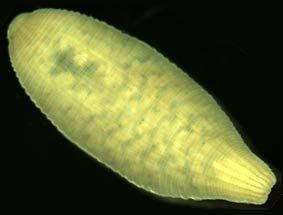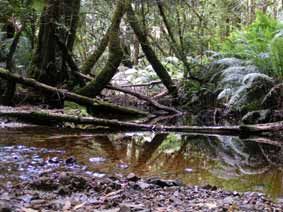Major Group: Hirudinea
Order: Rhynchobdellida
Family: Glossiphoniidae |
Descriptive Features: characteristically depressed, convex above
the body without distinct regions, appearing somewhat ovate, tapering anteriorly to a narrowly rounded head with a shallow open ventral sucker
mouth a small -circular pore within the sucker or on the anterior rim
dorsum roughened by obvious papillae, or smooth
body generally obviously 3-annulate
Total length: 7.0 – 39.0 mm
|

|
Alboglossiphonia |
|
|

|
Alboglossiphonia with eggs |
|
Taxonomic Checklist: Genera
Alboglossiphonia 5 species
Helobdella papillornata Govedich & Davies
Placobdelloides 3 species
Semilagenta hilli Goddard |
|
Distribution: NSW, SA, Tas, Vic, Qld, WA
Sensitivity Rating: SIGNAL grade 1
Functional Feeding Group: predators |

|
Hogarth Falls, Strahan Tas |
|
|
Ecology: Instream habitat: Glossiphoniidae species occur in streams, rivers, lakes and ponds. They are often found on the underside of stones and amongst vegetation.
Feeding ecology: There are both sanguivorous and predacious species. Sanguivorous species feed on amphibians, reptiles, birds and fish. They use a protrusible proboscis to penetrate the host's outer surface. Predacious species attack a wide range of prey including oligochaetes, insect larvae and molluscs. Helobdella papillornata feeds exclusively on snails (1-2 per day). It is a sit-and-wait predator which uses its anterior sucker to catch and subdue its prey. The leech penetrates the snail body through the shell aperture by pushing the proboscis out of itself, into the snail, and sucking body tissues into its oesophagus. The leech will feed until all soft tissues are ingested leaving an empty snail shell. After feeding, Helobdella papillornata remains inactive on the substrata for 6 to 24 hours. Young leeches, greater than 5mm, feed in small groups of 2 to 15, often alongside the parent or another mature individual, even several weeks after leaving the parent.
Habit:
Life history: Helobdella papillornata displays a high level of parental care involving brooding and direct feeding of the young. 20-70 fertilised eggs are attached to the ventral surface of the parent. These eggs are fragile and will not develop if removed from the parent. Hatching occurs after about 14 days and newly emerged young remain attached to the parent’s ventral surface for up to 60 days, until they are capable of hunting on their own. The young feed once every 7-14 days. Helobdella papillornata becomes reproductively mature three to four months after hatching. |
| |
Information Sources: Govedich 2001 & 2002, Richardson 1968, Paez et al. 2004, Govedich & Davies 1998
Key to Genera: Govedich 2001
Key to Species: Govedich 2001 |
|
|
|